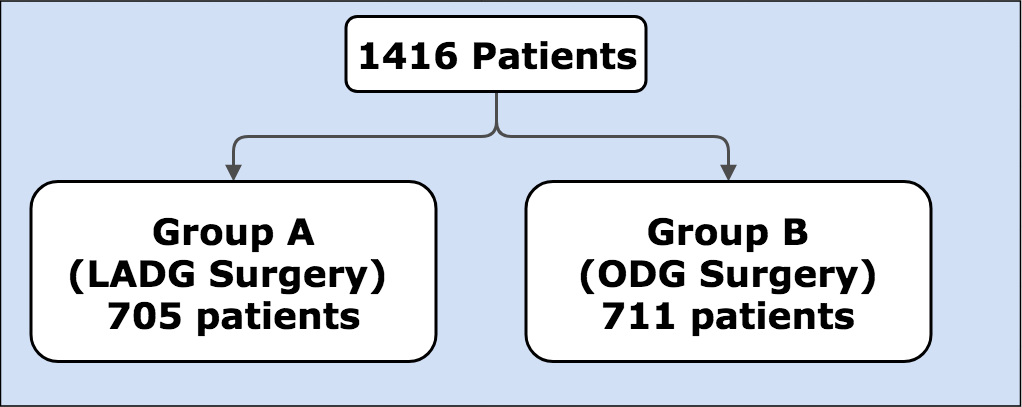Summary:
- Is an open or laparoscopic gastrectomy approach better to use for patients with Stage 1 Gastric cancer? Traditional gastrectomy surgeries are done by creating a large cut in the belly. This way, the surgeon can have access to a larger area. The laparoscopic method is newer. It makes a smaller cut and uses specialized tools with a camera to see inside. This study found that laparoscopic surgery can be a safe way to treat early stage gastric cancer.
Link:
Where?
- Korea
When?
- Published 2015, Annals of Surgery.
Impact Factor (IF):
- 8.980
This study compared two different types of surgery used to treat early stage gastric cancer. The first type is called laparoscopy-assisted distal gastrectomy (LADG). This is a minimally invasive type of surgery, where specialized tools are passed through smaller cuts in the abdomen. These tools can include small shears, staplers and clips with long handles to manipulate the stomach from further away. They often have tiny cameras which help the surgeon see inside the belly. In an LADG, the bottom part of the stomach affected by cancer is cut out using this technique.
Pros: LADG can cause patients less pain, shorten recovery time and potentially improve quality of life.
Cons: before this study, there was not a lot of proof showing in which situations LADG would be safe and helpful to use.
The other more common type of surgery used for gastric cancer is called an open distal gastrectomy (ODG). This means surgeons have to make a large cut down the middle of the belly. They can use hand-held tools and have closer access to the site of cancer. ODG is the traditional type of gastric cancer surgery. This study wanted to know if using LADG would be better than ODG for patients with Stage I gastric cancer. They compared the safety and results of the different techniques in two groups:
 1416 patients with Stage I gastric cancer were randomly assigned to Group A (LADG) or Group B (ODG) surgery. The experiment was done in Korea. Researchers made sure that all the surgeons participating had practiced both surgeries many times before the experiment. This was done to make sure the surgery was safe for patients.
1416 patients with Stage I gastric cancer were randomly assigned to Group A (LADG) or Group B (ODG) surgery. The experiment was done in Korea. Researchers made sure that all the surgeons participating had practiced both surgeries many times before the experiment. This was done to make sure the surgery was safe for patients.
Results: the researchers found that Group A patients had slightly fewer complications after surgery. For example, LADG surgeries caused fewer internal wounds than ODG surgeries. However, the average operation time was 40 minutes longer in Group A than in Group B. The authors think that this is because it is more difficult to control bleeding when the surgeon’s hands are farther away in LADG than in ODG.
The researchers concluded that LADG is a safe way to treat patients with Stage I gastric cancer.
Related Readings:
- ncbi.nlm.nih.gov/pubmed/22330034
- Viñuela, Eduardo F., et al. “Laparoscopic versus open distal gastrectomy for gastric cancer: a meta-analysis of randomized controlled trials and high-quality nonrandomized studies.” Annals of surgery 255.3 (2012): 446-456. Available from: doi: 10.1097/SLA.0b013e31824682f4.
- This paper is a secondary research article. The researchers did not create their own experiment. They looked at the results of many other experiments comparing LADG and ODG surgeries for treating patients with gastric cancer. This review found that the short-term outcomes of LDG showed that it was just as safe as ODG. However, the long-term outcomes are not yet known for sure. Also, gastric cancer is much more common in East Asian countries. Patients in these places are more likely to have a less advanced cancer than in North American countries where the disease is rarer. This could that more research is needed to see if LDG is always as safe as ODG in treating more advanced gastric cancer.
Citation:
- Kim, Wook, et al. “Decreased morbidity of laparoscopic distal gastrectomy compared with open distal gastrectomy for stage I gastric cancer.” Annals of surgery 263.1 (2016): 28-35. Available from: 10.1097/SLA.0000000000001346.


